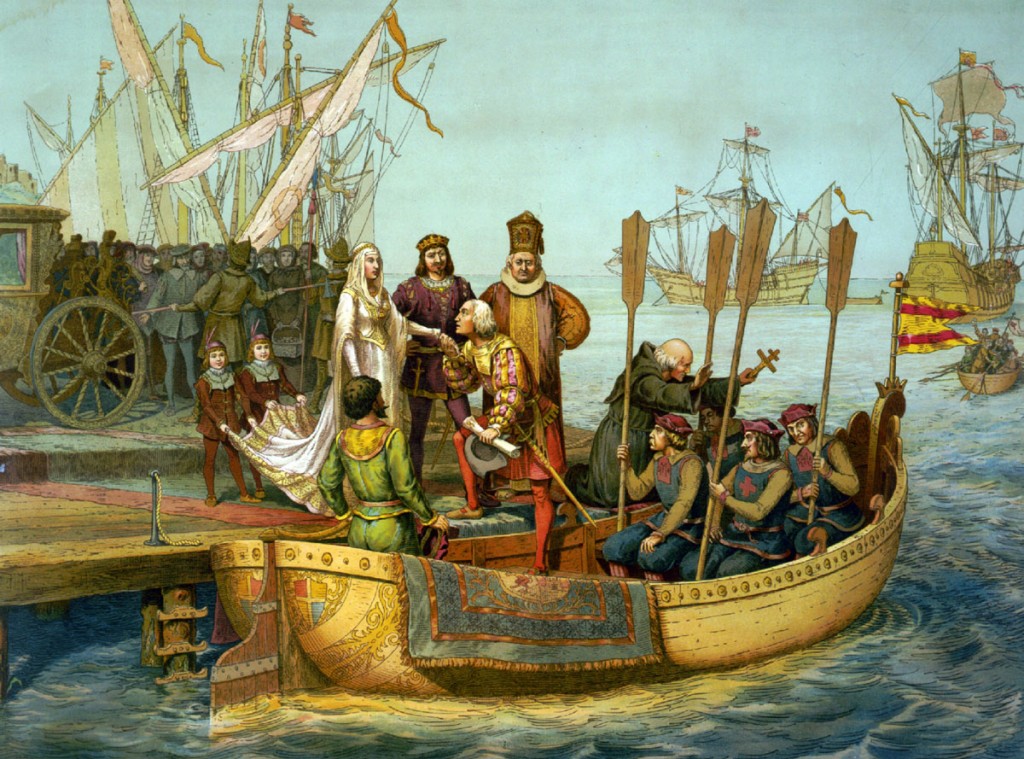
Discovery of America. For the discovery of America by the Vikings, see Viking Settlements in America. For the voyage where the discovery was made in 1492, see First Voyage of Columbus. For the human arrival in America, see Poblamiento de América. A romantic vision of the arrival of Christopher Columbus in America (Dioscorus Puebla, 1862). Discovery of America is called the historical event of October 12, 1492, consisting of the arrival in America of an expedition led by Christopher Columbus by order of the Catholic Monarchs, Isabella of Castile and Ferdinand of Aragon. Columbus had left the Port of Palos two months and nine days before and, after crossing the Atlantic Ocean, he arrived at an island in the American continent, Guanahani, believing that he had arrived in India. This fact is one of the fundamental moments of universal history and represents the meeting of two worlds that had evolved independently from the settlement of America. Several years after the arrival of Columbus, the Europeans were realizing that the place they had arrived to was not connected by land to Europe and the rest of the "known land," as expected from India, but it formed a continent different. Thus, after 1507 it was called America. In the centuries after the discovery of the new world, Spain, Portugal and to a lesser extent England, France, the Netherlands and other European powers competed for the exploration, conquest and colonization of the American continent, and enslaved millions of people kidnapped in Africa , which led to processes of dissolution and anomie of millenary culture, as well as the emergence of new ethnic, cultural and political conformations. Controversy exists regarding the use of the term "discovery" to refer to the arrival of the Columbus expedition, since, on the one hand and from the point of view of humanity, America was already populated and had been discovered by the first human beings that arrived to the continent approximately 14,000 years ago, and, on the other hand, there is a probable first European arrival made by the Vikings in the 10th century, although without evidence of contact. The contact with the Spaniards had an enormous impact in America. Different plant and animal species were introduced, such as the horse, a species introduced in the second voyage of Christopher Columbus, and which had been extinct in America since ancient times. There is a clear distinction between the "act of discovery itself", understood as the series of trips made by Spanish sailors who arrived in America and the encounter between cultures, and the subsequent historical process known as the conquest of America that the Europeans made next . Due to the physiognomic features of the Olmec sculptures in Mexico, without knowing for sure their ethnic origin, evidently they represent people of African descent with whom they either had contacts or were the inhabitants themselves representing themselves. Although this civilization existed long before the birth of Christ, in 1311 it was investigated whether Abubakari II, meek who abdicated the throne, could have reached American shores in what is now Brazil. On the North American Atlantic coast it shows a unique Viking settlement in Newfoundland, well documented archaeologically and that was abandoned ten years later without contacts or repercussion. On the Pacific coast there is material and genetic evidence that small groups of Malay-Polynesian navigators could arrive on the coasts of South America, before the arrival of Columbus. However, in neither case did these groups have a permanent impact, so in a way they are not considered a conscious "discovery" of a civilization by another civilization. A few years before the discovery of America, the Portuguese maritime voyages to India bordering the coast of Africa and following the eastward course across the Indian Ocean served as a stimulus to other European navigators who believed that it was possible to reach the regions of East Asia sailing west.